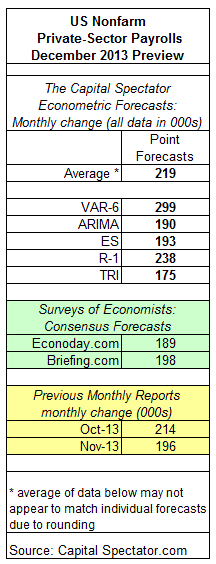Private nonfarm payrolls in the US are projected to increase by 219,000 (seasonally adjusted) in tomorrow’s December update from the Labor Department, according to The Capital Spectator’s average econometric point forecast. The projected gain is moderately above the previously reported increase of 196,000 for November. Meanwhile, The Capital Spectator’s average December projection exceeds a pair of consensus forecasts based on surveys of economists.
Here’s a closer look at the numbers, followed by brief definitions of the methodologies behind The Capital Spectator’s projections:
VAR-6: A vector autoregression model that analyzes six economic time series in context with private payrolls. The six additional series: ISM Manufacturing Index, industrial production, aggregate weekly hours of production and nonsupervisory employees in the private sector, the stock market (S&P 500), spot oil prices, and the Treasury yield spread (10-year less 3-month T-bill). The forecasts are run in R with the “vars” package.
ARIMA: An autoregressive integrated moving average model that analyzes the historical record of private payrolls in R via the “forecast” package.
ES: An exponential smoothing model that analyzes the historical record of private payrolls in R via the “forecast” package.
R-1: A linear regression model that analyzes the historical record of ADP private payrolls in context with the Labor Department’s estimate of US private payrolls. The historical relationship between the variables is applied to the more recently updated ADP data to project the government’s estimate of private payrolls. The computations are run in R.
TRI: A model that’s based on combining forecasts with a technique known as triangular distributions. The forecast combinations include the following projections: Econoday.com’s consensus forecast data and the four predictions generated by the models noted above, i.e., VAR-6, ARIMA, ES, and R-1. The forecasts are run in R with the “triangle” package. For more information about TRI, see this post.
